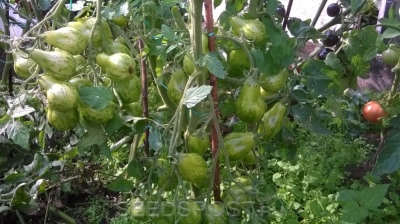
- Category: grade
- Growth type: semi-determinant
- Appointment: fresh consumption, for whole fruit preservation
- Ripening period: mid-season
- Ripening time, days: 110-120
- Growing conditions: for open ground, for closed ground
- Bush size: tall
- Bush height, cm: 120-150
- Ripe fruit color: golden with green intermittent stripes
- Fruit shape: elongated pear-shaped, with a spout
Especially for those who prefer to grow unusual vegetables, a variety called Michael Pollan was bred. This variety will attract the attention of those who are interested in experiments not only in the field of gardening, but also in cooking.
Description of the variety
The non-standard cultivar has a semi-determinate growth type. It is intended for cultivation in open or closed ground, depending on weather conditions. The harvested fruits are versatile. They are suitable for canning whole fruits or eating fresh.
The bushes are tall and reach a height of 1.2-1.5 meters. Despite this growth, the plants are compact. Moderate leafiness. One brush forms up to 30 tomatoes of the same size.
The main qualities of the fruit
The appearance of the fruit will noticeably distinguish the Michael Pollan variety against the background of all the main ones. The color is golden, with pronounced intermittent green stripes. In weight, they gain up to 100 grams. But the average weight varies from 60 to 90 grams. The shape of the tomatoes is very similar to a pear, slightly elongated.
The pulp of a rich emerald color is very juicy and moderately dense. The skin is smooth with a glossy shine, dense and reliably protects vegetables from cracking during storage and transportation. At the same time, it does not cause inconvenience when eating fresh tomatoes.
Due to the unusual color, many gardeners compare the fruits with watermelons. They make colorful and delicious salads. Tomatoes are also great for preparing hot meals.
Taste characteristics
The taste is excellent. The taste is sweet and expressive, with a pleasant and light sourness. When eaten, spicy notes are felt.
Ripening and fruiting
The vegetable culture is considered mid-season, and the ripening period is from 110 to 120 days from the moment of emergence to the collection of ripe vegetables.
Yield
High yields are noted regardless of growing conditions. In one season, you can get up to 3 kilograms of juicy vegetables from one bush.
The timing of planting seedlings and planting in the ground
Vegetable culture is cultivated through seedlings, which can be grown with your own hands. Sowing seed for seedlings is carried out from March to April. The grains are deepened into the ground by no more than 1 centimeter.
The first shoots can be observed after 4-8 days, provided that the seedlings were provided with comfortable conditions for germination. Planting bushes in open ground or greenhouses is carried out from May to June.
When germinating seeds you need:
- maintain a temperature regime of 20-25 degrees Celsius;
- use light and fertile soil;
- irrigate regularly with warm and settled water;
- ventilate containers to prevent moisture stagnation.
Note: When using seed that has been collected with your own hands, it must be processed. A solution for stimulating growth or with the addition of potassium permanganate is suitable.
Initially, the seed is germinated in a common container, but after the appearance of a pair of true leaves, a pick is performed. Plants are planted in separate containers for further germination. Now the seedlings need natural or artificial lighting if there is not enough sunlight. As soon as the bushes reach 50-55 days of age, they can be transferred to a permanent growing site.

Growing tomato seedlings is an extremely important process, because it largely depends on whether the gardener can harvest at all. All aspects must be taken into account, from seedbed preparation to planting in the ground.
Landing scheme
On one square meter of the site, from 3 to 4 bushes are grown. A gap of 40-50 centimeters is left between the holes.

Growing and care
Despite the originality of this variety, it does not have any special care requirements. In order to get a stable and tasty harvest from season to season, you only need to perform a certain number of procedures.
A prerequisite for the cultivation of tomatoes is timely watering. Irrigation should be moderate so that the bushes do not suffer from high humidity. The culture is watered about once a week. In dry weather, the frequency of irrigation is increased. Gardeners strongly recommend using warm or settled water.
Tall bushes need support. Otherwise, the shoots will tilt towards the ground under the weight of the tomatoes, and the contact of vegetables with the ground must be avoided. Loose branches can break. The support is installed immediately after the rooting of the bushes. Twine is used to fasten the stem, and the branches are fastened with nylon strips.
Fruit crops need to be regularly fed with nutrients and nutrients. This procedure is carried out three times per season. Both organic and mineral fertilizers are used. It is very important to observe the measure, otherwise feeding will have the opposite effect.
Bushes of the Michael Pollan variety are formed into 3 or 4 stems. This option is considered the most convenient and effective. Also, stepchildren are periodically removed so that the bushes do not waste energy on unnecessary lateral processes. As additional measures, the beds are treated with protective compounds that will protect the crop from diseases and pests.




A plant needs different micronutrients at each stage of growth. All fertilizers can be divided into two groups: mineral and organic. Folk remedies are often used: iodine, yeast, bird droppings, eggshells.
It is important to observe the rate and period of feeding.This also applies to folk remedies and organic fertilizers.



























































































